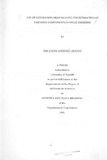Use of generation mean scaling for estimation of variance components in maize breeding
Abstract
Genetic studies were carried out to estimate the
variance components in maize using six crosses, A x F, A
X 64, A x 8, F X 64, F x 8 and 8 x 64. The four parental
inbred lines (A, F, 64 and 8), the F1
, F2 and backcross
generations of these crosses were grown in a randomized
complete block design with three replicates at National
Agricultural Research Centre, Kitale; Western Agricultural
Research Centre, Kakamega; Soy and Sabwani, between April
and October 1991. Diallel and generation mean analyses
were done based on data from twelve randomly selected
plants in each plot for plant height, ear height, grain
yield, ear lengtP, 200-grain weight and kernel row number.
Lodging percentage was determined for the whole plot.
According to the dial leI analysis, the additive gene
effects were relatively more important for all the traits
except grain yield, 200-grain weight and lodging
,percentage. Non- additive gene effects played
insignificant- roles in manifestation of the traits
studied.
The generation mean analysis revealed that both
additive and dominance genetic variances were important
for grain yield, ear length, 200-grain weight, plant
height, ear height and kernel row number. The variability
attributable to dominance genetic variance was much
greater in all cases. Lodging percentage was mainly
governed by additive genes. In most crosses additive x
additive and dominance x dominance genetic variances were
more important than additive x dominance genetic variance
at all sites. In all cases the manifestation of various
genetic variance components varied according to crosses
and experimental sites.
Among the parental cultivars, inbred lines F and
64 had high general combining ability estimates for yield
and yield component traits at most sites, and hence were
the most promising for yield improvement. The crosses
8 X 64, A x F, A x 8 and F x 64 also had high specific
combining ability estimates for grain yield and
could be used Lh further selection and hybrid development
programmes. Cross 8 x 64 was the most heterotic at most
sites for grain yield, plant height, ear height and ear
length while crosses A x F and F x 8 were the most
heterotic at most of the sites for characters, 200-grain
weight and kernel row number respectively. Double cross
(A x 64) x (F x 8) had the best predicted yield
performance at Kitale, Kakamega and Soy.
Citation
Master of Science in genetics and plant breedingPublisher
Department of Crop Science

